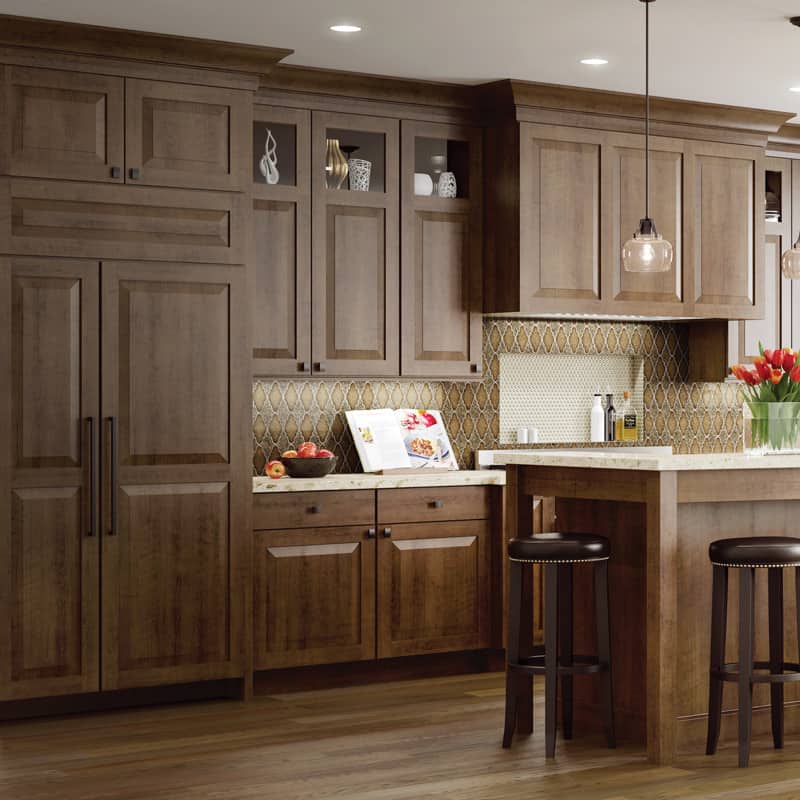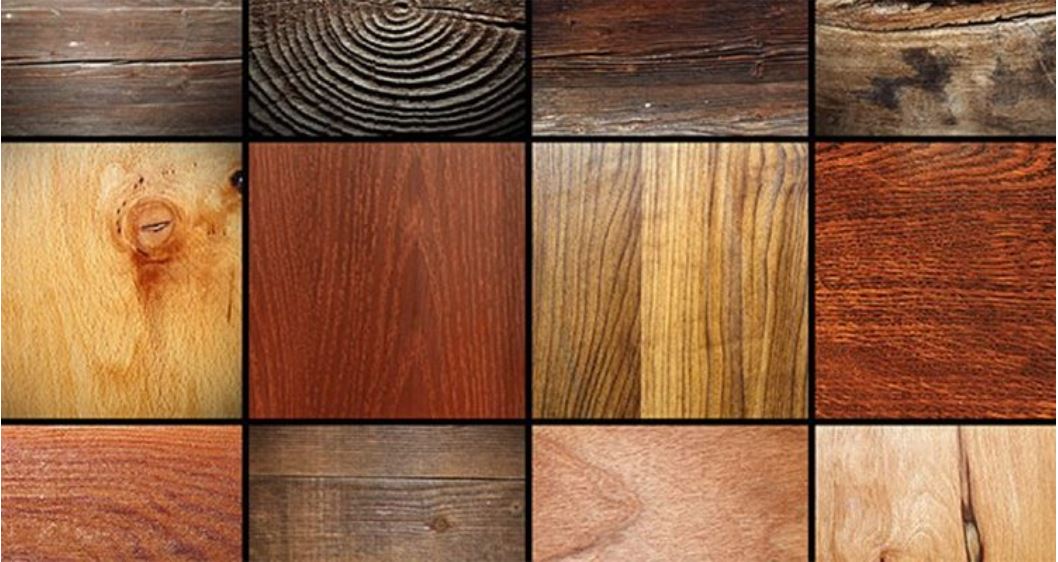The Appeal of Mixed Wood Kitchen Cabinets

Mixing different wood types in kitchen cabinetry is a design trend that offers a unique blend of visual appeal and functionality. This approach goes beyond simply choosing a single wood species, allowing homeowners to create kitchens that are both stylish and personalized.
Aesthetic Advantages of Mixing Wood Types, Mixed wood kitchen cabinets
Mixing wood types in kitchen cabinetry offers a range of aesthetic advantages that can elevate the overall design of the space. The combination of different wood tones, grains, and textures creates visual interest and depth, adding a layer of complexity and sophistication to the kitchen.
- Contrast and Visual Interest: Mixing wood types with contrasting colors and grain patterns creates a dynamic and eye-catching effect. For example, pairing a light-colored wood like maple with a darker wood like walnut can create a striking contrast that adds depth and dimension to the kitchen design.
- Textural Variety: Different wood species have unique textures that can be used to create visual interest. For example, a smooth, polished wood like cherry can be paired with a rougher, rustic wood like reclaimed barnwood to create a tactile and visually appealing contrast.
- Accentuating Architectural Features: Mixing wood types can be used to accentuate specific architectural features of the kitchen, such as an island or a custom hood. Using a contrasting wood for these elements can draw attention to them and create a focal point in the space.
Impact of Different Wood Tones and Grains on Kitchen Design
The choice of wood tones and grains significantly impacts the overall feel and atmosphere of the kitchen. Lighter wood tones, such as maple and birch, create a bright and airy ambiance, while darker wood tones, such as walnut and cherry, can create a more warm and inviting atmosphere.
- Light Wood Tones: Light wood tones, such as maple and birch, are often associated with modern and contemporary kitchen designs. Their bright and airy appearance can make a small kitchen feel larger and more spacious.
- Dark Wood Tones: Dark wood tones, such as walnut and cherry, are often associated with traditional and rustic kitchen designs. Their warm and inviting appearance can create a cozy and inviting atmosphere.
- Wood Grains: Wood grains can also add visual interest and texture to kitchen cabinets. For example, a wood with a prominent grain pattern, such as oak, can add a rustic and natural feel to the space.
Examples of Successful Mixed Wood Combinations in Kitchen Cabinets
There are numerous successful examples of mixed wood combinations in kitchen cabinets. Some popular combinations include:
- Maple and Cherry: This combination offers a classic contrast between a light and airy wood (maple) and a warm and rich wood (cherry).
- Walnut and Oak: This combination creates a striking contrast between a dark and elegant wood (walnut) and a light and rustic wood (oak).
- Reclaimed Barnwood and Maple: This combination combines the rustic charm of reclaimed barnwood with the clean lines and modern appeal of maple.
Planning and Design Considerations

Creating a kitchen with mixed wood cabinets requires careful planning and design considerations to ensure a harmonious and aesthetically pleasing result. This involves choosing compatible wood species, finishes, and styles to achieve a balanced and cohesive look.
Choosing Compatible Wood Species
Selecting compatible wood species is crucial for a successful mixed wood cabinet design. Consider the following factors:
- Color and Grain: Choose woods with complementary colors and grain patterns. For example, a light wood like maple can be paired with a darker wood like walnut for a contrasting effect.
- Hardness and Durability: Consider the hardness and durability of each wood species. Hardwoods like oak and maple are more resistant to scratches and dents, making them suitable for high-traffic areas like kitchen islands. Softer woods like pine and cherry are more prone to damage and may be better suited for less-used areas.
- Cost: Wood prices can vary significantly depending on species, availability, and quality. Consider your budget when choosing wood species.
Selecting Finishes
Finishes play a significant role in determining the overall look and feel of your mixed wood cabinets. Here are some tips for selecting compatible finishes:
- Color: Choose finishes that complement the natural colors of the wood species. For example, a warm honey stain can enhance the natural beauty of oak, while a dark walnut stain can create a rich and sophisticated look on cherry.
- Sheen: Consider the sheen of the finish. A high-gloss finish can make cabinets appear more modern and sleek, while a matte finish can create a more traditional and rustic look.
- Distressing: Distressed finishes can add a vintage or farmhouse feel to cabinets. Choose a distressing technique that complements the overall style of your kitchen.
Creating a Balanced and Cohesive Look
A well-planned mixed wood cabinet design should achieve a balanced and cohesive look. Here are some tips:
- Use a Dominant Wood: Choose one wood species as the dominant wood and use it for the majority of the cabinets. The other wood species can be used for accents, such as island cabinets or upper cabinets.
- Repeat the Pattern: Repeat the pattern of the mixed wood design throughout the kitchen. For example, if you use a light wood for the lower cabinets and a dark wood for the upper cabinets, repeat this pattern in other areas of the kitchen, such as the backsplash or countertop.
- Use Consistent Hardware: Choose consistent hardware for all the cabinets to create a unified look.
Practical Aspects of Mixed Wood Cabinets: Mixed Wood Kitchen Cabinets

Mixed wood kitchen cabinets – While mixing wood species adds visual appeal, it’s essential to consider the practical aspects. This includes the durability and maintenance requirements of different wood types, as well as potential challenges and solutions associated with mixing them.
Durability and Maintenance of Different Wood Types
The durability and maintenance needs of different wood species vary significantly. Understanding these differences is crucial for selecting appropriate wood types for your kitchen cabinets.
- Hardwoods: Hardwoods like oak, maple, and cherry are known for their strength and durability. They resist scratches and dents well, making them ideal for high-traffic areas like kitchens. However, hardwoods can be more expensive and require regular maintenance, such as oiling or waxing, to maintain their beauty.
- Softwoods: Softwoods such as pine and fir are more affordable and easier to work with. However, they are less durable than hardwoods and prone to scratches and dents. They also tend to be more susceptible to moisture damage, requiring careful sealing and maintenance.
- Engineered Woods: Engineered woods, like plywood and MDF, offer a more affordable and consistent alternative to solid wood. They are generally more resistant to warping and moisture damage, making them suitable for kitchen cabinets. However, they may not have the same natural beauty as solid wood.
Challenges Associated with Mixing Wood Species
Mixing wood species in cabinetry presents unique challenges, such as differences in grain patterns, color variations, and finish compatibility.
- Grain Patterns: Different wood species have distinct grain patterns. When mixed, these variations can create a visually distracting or uneven appearance. Carefully selecting wood species with complementary grain patterns can help mitigate this issue.
- Color Variations: Even within the same wood species, there can be variations in color. Mixing different wood types can exacerbate these variations, resulting in an uneven or disjointed look. To address this, consider using stains or paints to unify the colors of the different wood species.
- Finish Compatibility: Different wood species may require different finishes. Mixing wood types that require incompatible finishes can lead to uneven or inconsistent results. For instance, some wood species may require oil-based finishes, while others may require water-based finishes. It’s important to choose compatible finishes to ensure a consistent and aesthetically pleasing result.
Solutions for Addressing Challenges
Several solutions can help address the challenges associated with mixing wood species in cabinetry:
- Compatible Finishes: Using compatible finishes can help unify the appearance of different wood species. For example, applying a clear coat or stain over all the wood surfaces can create a consistent look and feel.
- Construction Techniques: Careful construction techniques can also help mitigate the challenges of mixing wood species. For example, using a combination of solid wood and engineered wood can provide both durability and affordability while ensuring consistency in the final product.
- Professional Expertise: Consulting with a professional cabinet maker or designer can help ensure the successful integration of different wood species. They can provide guidance on selecting appropriate wood types, finishes, and construction techniques to achieve the desired aesthetic and functionality.
Mixed wood kitchen cabinets offer a unique and rustic charm, often featuring a blend of different wood species and finishes. If you’re looking to refresh the look of your cabinets, you might need to strip off old paint or varnish.
The best way to strip paint from wood cabinets depends on the type of paint and the condition of the wood. Once you’ve successfully stripped the cabinets, you can stain or paint them to match your desired aesthetic, further enhancing the natural beauty of your mixed wood kitchen cabinets.
Mixed wood kitchen cabinets offer a unique blend of warmth and character, bringing a touch of rustic charm to any space. While designing your kitchen, don’t forget about creating a cozy entertainment area. A small projector for bedroom ceiling can transform your kitchen into a home theater, allowing you to enjoy movies or shows after a delicious meal.
The warmth of mixed wood cabinets complements the cinematic experience, making your kitchen a truly inviting space for relaxation and entertainment.
